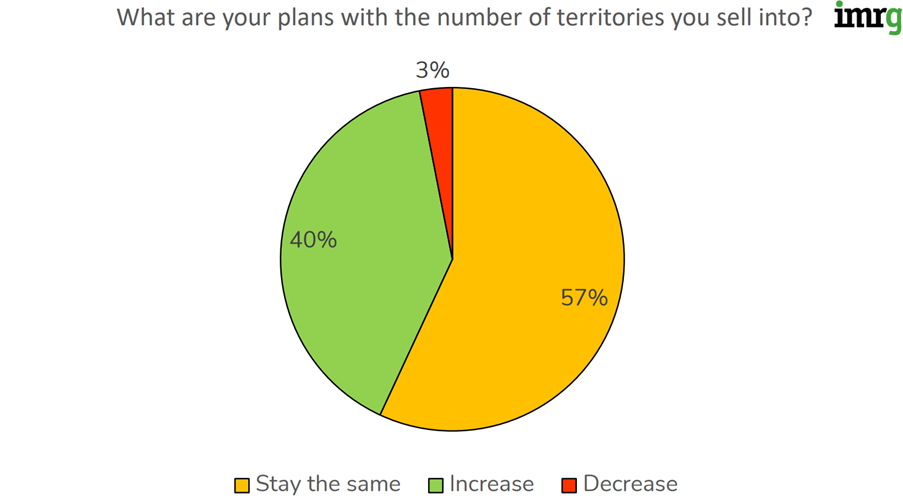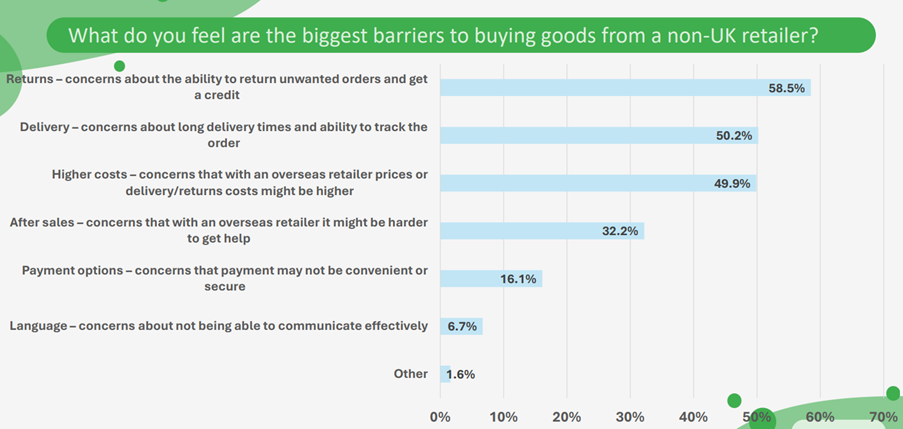By Ellie-Rose Davies, Content Executive at IMRG
In this blog, we share expert tips to help retailers optimise cross-border eCommerce performance with insights from industry specialists.
Read on to explore IMRG’s latest findings on cross-border trade, practical advice on localisation, and strategies for pricing, payments, and costs. Plus, get key tips on delivery, returns, and fraud prevention to support your international growth.
IMRG’s latest insights into cross-border trade
Retailer-led insights
For 47% of retailers, cross-border is within their top 5 priorities for this year. 89% of retailers sell into Europe, and the second most popular territory was the Americas (57%). Oceania, Middle East, and Asia are also popular (see chart below).

Source: IMRG Delivery & Cross-Border research 2025
Interestingly, 40% of retailers plan to increase the number of territories they sell into, and only 4% plan to decrease.

Source: IMRG Delivery & Cross-Border research 2025
Consumer-led insights
This chart below shows what consumers believe to be the biggest barriers when buying goods from outside their home territory.

Source: IMRG’s Consumer Home Delivery research 2025
The top barrier is returns (close to 60%), with concerns about the ability to return unwanted orders and get a refund/credit. The second barrier is delivery (around 50%), with worries about long waiting times and the ability to track their order. Another significant barrier is higher costs (around 50%), which shows retailers should be transparent with their pricing and avoid consumers experiencing unexpected costs.
This same research also revealed to those retailers who sell into the UK from overseas that around 30% of UK consumers are likely to purchase from a ‘non-UK’ website every 1-3 months.
Industry expert fulfilmentcrowd have also carried out consumer research on cross-border trade which showed that ‘79% of UK consumers have shopped internationally and nearly half done so in the last year.’
The barriers fulfilmentcrowd have noted are ‘40% are put off by high shipping fees, 38% by long delivery times, and 34% by customs charges.’ What can help is Trust, ‘with customer reviews (46%) and transparent costs (45%) top priorities.’
Some key things to remember to compete globally are ‘retailers can streamline shipping, simplify returns, and communicate clearly.’
Optimising cross-border trade
Implement localisation
Localisation is a fantastic way to build trust and subsequently grow conversions. A one site for all approach runs the risk of alienating cross-border consumers and making them feel as though the purchase they’re about to make is a risk, brining up feelings of fear relating to all the barriers expressed earlier in this blog.
An advocate for localisation is Justin Thomas, VP Sales, EMEA North at Akeneo who expresses that ‘Cross-border shoppers around the world want to shop directly on localised websites of their favourite British brands and enjoy friction-free and familiar shopping experiences.’
To achieve this, Justin recommends that ‘UK brands use AI-driven content translation and localisation tools to enhance internal product data processes and ensure content is translated, localised, and optimised for any market.’
He provides the example of ‘KARL LAGERFELD, the namesake fashion brand of its Founder, who uses native GenAI functions within its Product Information Management (PIM) to support content creation, enhance its SEO performance, and transcribe content into nine languages for product description pages across its 33 international markets.’
Justin also promotes the use of ‘AI-powered sentiment analysis which enables retailers to craft messaging and campaigns that align with the cultural nuances, preferences and values of specific regions on social media platforms.’
Navigating local regulations is another crucial aspect of global retail operations; ‘AI technology can be equipped to ensure that brands stay compliant with regional laws and standards. Whether it’s adhering to regulations like Natasha’s Law here in the UK, or data privacy laws like the California Consumer Privacy Act (CCPA), AI helps brands navigate complex regulatory landscapes efficiently and compliantly.’
Alexander Otto, Head of Corporate Relations at Tradebyte reiterates the value of localisation, voicing that ‘Expanding internationally in 2025 requires more than just translation; it demands true localisation – region-specific pricing, optimised inventory, and cultural relevance.
‘A retailer expanding into Germany may succeed by focusing on high-quality craftsmanship and sustainable goods, for example, while in France, emphasis on luxury and design might drive sales,’ says Alexander.
‘Similarly, marketing campaigns must reflect local values and aesthetics to connect with audiences meaningfully…and success lies in leveraging data to drive flexible marketplace strategies, ensuring brands scale efficiently while maintaining a local touch.’
Experts at PayPoint echo the need for retailers to ‘adapt marketing strategies to resonate with diverse audiences, reflecting cultural sensibilities and consumer behaviours.’ They say, ‘In the same way the UK witnesses’ regional differences in customer expectations – whether relating to speed, cost-effectiveness or packaging credentials – so too does the retail landscape on a bigger scale, necessitating a tailored approach to international eCommerce.
A crucial point to consider, raised by PayPoint, is that retailers who sell cross border must comply with ‘international regulations and understanding of regional market nuances, which is paramount to foster trust and avoid legal pitfalls.’ They say, ‘Differences within markets themselves must also be adhered to, such as in the US where regulation can vary by state and affects how products are marketed and sold.’
Price Trakker reflect on the necessity to meet varying needs; ‘Retailers must adapt pricing dynamically to reflect currency fluctuations, offer region-specific payment options, and optimise logistics to ensure fast, transparent delivery. Customers in different markets have varying expectations. European shoppers prioritise flexible returns, while US customers value fast shipping. A strong example is Zara, which refines its regional strategies to match consumer behaviours, ensuring consistency in brand experience while catering to local nuances.’
Fine tune pricing, payments and costs
When selling cross border, it is essential to fine tune your pricing, payments, and costs strategies to reflect that of the market you are selling into.
Prisync, pricing experts, share their advice: ‘Customers are no longer shying away from shopping internationally if they believe the product has proven its worth or convenience, which means getting a good deal on the price.’
They say, ‘Accepting payments in local currencies is a big plus for convenience, but retailers must also consider shipping costs for their profit when pricing their products.’
A bonus tip is ‘Once the delivery is complete, retailers can request reviews in exchange for discount coupons or promote smooth deliveries, even during peak seasons.’
Reflecting on payments is Kamran Hedjri, CEO at PXP, who shares that ‘Some businesses are making significant strides in cross-border payments, with merchants increasingly expanding their payment method offerings.’
Kamran notes how ‘There is still considerable work to be done in making cross-border payments as convenient and frictionless as domestic transactions. Current obstacles include outdated legacy technology platforms and a lack of interoperability between national payment systems. These challenges mean that in some cases, a cross-border payment can take several days and cost up to 10 times more than a domestic payment, creating significant friction for global consumers and businesses alike.’
Simon Dyer, Regional Vice President, UK & Nordics at Mirakl emphasises the importance of being transparent with costs. He says, ‘A critical element often overlooked is providing customers with a ‘Full Duties Paid’ experience, eliminating unexpected handling costs after checkout that can damage customer satisfaction.’
‘The industry is evolving to ensure buyers complete their purchase with full transparency about all costs involved,’ says Simon.
Simon also reflects on payments, stating that ‘Fortunately, recent developments are creating innovative solutions to improve the speed and efficiency of cross-border payments. Emerging messaging standards like ISO 20022 and collaborative projects from the G20 are paving the way for more streamlined international transactions.’
Tackle the top two barriers: Delivery and returns
IMRG’s research, supported by other industry experts, show that delivery and returns are the top two barriers to cross-border consumers. Therefore, it is categorical that these two stages of the customer purchasing journey are optimised.
Gavin Murphy, CMO at Scurri, comments, ‘An exceptional delivery experience is as close as it comes to a universal ‘must-have’ for consumers, regardless of which international market British brands are looking to sell in. Prioritising customer-centric delivery experience enhances satisfaction, builds trust and ultimately fuels long-term success.’
‘This includes the ability to provide an Estimated Day of Delivery (EDD) and tracking data, serving delivery options as early as possible within the customer journey, and providing access to locally recognised and trusted last-mile carriers.’
Gavin continues, ‘Lastly, there is the topic of tariffs. These are certainly on the mind of British brands with 30% of retailers highlighting the possibility of tariffs increasing the cost of goods to consumers as one of the main challenges to performance and growth in the coming year.’
‘As yet, it is unclear what may come our way in terms of tariffs – with 40% of British retailers reporting they are still unsure whether they will diversify their supply chains – but optimising delivery management strategies is key for businesses selling into the US to limit potential impact should the trade winds change over the Atlantic.’
Now to talk about returns. Marko Kiers, Chief Commercial Officer at ReBound, explains ‘Optimising eCommerce cross-border performance isn’t just about speedy delivery; returns are a critical part of building a truly end-to-end experience.’
‘Customers increasingly prefer to return items locally and expect to receive refunds fast. This requires local carriers and strategically placed hubs across key regions including the UK, EU, and US. The hubs allow returned items to be registered, graded, and sorted locally, minimising unnecessary parcel travel.’
Marko says, ‘It’s far more efficient to resell a returned item to a new customer in the same country, rather than shipping back and forth across borders. Imagine a product being shipped to France, returned to the US, then resold to another customer in France. The situations are costly and avoidable.’
Mitigate fraud
Another key element to consider when selling cross border is fraud and how to best mitigate it.
Nikhita Hyett, General Manager EMEA at Signifyd says, ‘eCommerce is global, offering UK retailers significant opportunities for growth. Notably, UK cross-border sales have increased by 4% year-on-year, with the broader EMEA market experiencing a 6% rise, according to Signifyd’s recent data.’
‘However, entering new markets comes with challenges, from fraud and returns abuse to compliance and fulfilment complexities. Fraud tactics differ by region, and cross-border orders are often flagged as higher risk, which can lead to false declines if not managed carefully. Return abuse is another concern, especially in markets where customers expect generous and fast returns.’
What are the key takeaways?
Ultimately, retailers selling cross-border should consider localisation, refine their pricing and payments strategies, be transparent with costs, ensure they’re tackling the two biggest barriers (delivery and returns), and limit fraud.
What tips would you provide?
Want to read more? Here are the 5 latest blogs from IMRG:
- How to make a seamless customer experience a reality – IMRG
- The type of personalisation customers want in 2025 – IMRG
- Redefining paid media roles: How AI shifts the focus from execution to strategy – IMRG
- Trends within fashion and beauty eCommerce – IMRG
- Future of eCommerce: AI & dynamic pricing – IMRG
Published 07/04/25


